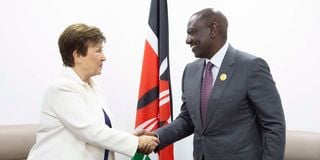Premium
Kenya to benefit from Sh3.6 billion carbon offset deal

President William Ruto held a meeting with the IMF Managing Director, Kristalina Georgieva on the sidelines of COP27 in Sharma El-Sheikh, Egypt.
Kenya will receive more than Sh3.6 billion in a deal under which Kenyan farmers will benefit in a carbon offset investment.
In an announcement to launch the fund on the sidelines of the ongoing Climate Change Conference (COP27) in Sharm el-Sheikh in Egypt, Kenya was named one of the first countries that will receive funding from the Nature, People and Climate Investment Programme, newly launched by the Climate Investment Fund (CIF).
The money, a joint contribution from Italy, the United Kingdom and Sweden, will see Kenya and other countries selected for the fund, including Malawi, Mozambique, Namibia and Tanzania, Zambia, Egypt, Dominican Republic and Fiji, jointly benefit from this over Sh42 billion programme.
Speaking at the event, CIF chief executive Mafalda Duarte said 55 countries applied to be part of the programme over the past few months, one third of developing countries, an indication of the urgent need for climate finance.
“The CIF governing board made the final decision following a comprehensive process, informed by independent experts. The next step is for the selected countries to prepare investment plans in collaboration with partner multilateral development banks,” said Ms Duarte.
In 2021, “at the COP26 we announced more than a Sh18 billion ($150 million) investment from climate asset management spanning six countries in Eastern and Southern Africa, including Kenya, Ethiopia, Uganda, Tanzania, Malawi and Zambia,” said Global EverGreening Alliance CEO Chris Armitage.
“That programme started implementation about four months ago, and [in the region it] is being coordinated out of Nairobi.
“On Wednesday, we had an announcement of [an] additional Sh42 billion ($330 million), of which the first Sh22 billion ($180 million) is going to be directed into the same six countries to build on and scale out on the first investment on climate asset management. Of the Sh22 billion ($180 million), about Sh18 billion ($30 million) … is earmarked for Kenya.”
The bulk of that money, he said, will be used in the first five years of the programme, which will start during 2023.
Speaking at the same event, Irene Ojuok, a researcher and expert working with local communities in Kenya, said, the programme’s goal is to restore the landscape of the communities bearing the biggest burden of climate change.
“Through this, we will sensitise and facilitate farmers … to plant and conserve especially trees, and in the long run, accrue the carbon credits.”
Kenya is facing the worst drought in 40 years, with more than half of its counties affected.
“When communities face livestock loss, they turn to the landscape to survive. This programme comes in to fit into challenges these communities are facing, to build their resilience from climate change,” Ms Ojuok explained.
Through this, she said, they can restore landscapes using simple low-cost farmer-managed natural regeneration models.
Restoring trees
“These have proven to be effective in restoring local trees that are very important to the farmer, especially in the semi-arid regions. This deals directly with the challenges farmers face and expose them to activities that are destructive to the environment,” she added.
The programme will focus on promoting and protecting natural environments. This will include supporting the first group of participating countries after they present their investment plans to meet some of their most pressing climate challenges.
The people and climate investment programme in Kenya is intended to support sustainable forest management and water tower protection and restoration in Mt Elgon and Cherangany.
The final decision was reached after a vigorous process informed by independent experts. The next step is for the selected countries to prepare investment plans in collaboration with partner multilateral development banks.
This story was produced as part of the 2022 Climate Change Media Partnership, a journalism fellowship organised by the Internews Earth Journalism Network and the Stanley Centre for Peace and Security.





